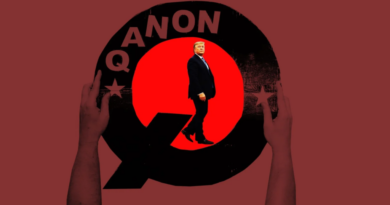The Secrets of QAnon’s Appeal

Critics accuse QAnon’s chroniclers in the media of failing to learn Trump-era lessons about the role mainstream media plays in amplifying disinformation and extremist content. And more than any behind-the-scenes revelation about the conspiracy itself, “Into the Storm” is most striking in what it reveals about how the beliefs and language of the paranoiac far right have spread like wildfire through our culture and politics — and the role the media has, or hasn’t, played in that phenomenon. (As if illustrating this point, documentarian Cullen Hoback uses once-esoteric terms like “red-pilled” and “Q-drops” as casually as if they were policy lingo and he were a surrogate trying to sell the Biden infrastructure package on the Sunday shows.)
Hoback provides a unique insight by gaining extensive access to not just QAnon’s followers, but its likely creators. And depending on your perspective, what he learns might be a relief, a cause for alarm, or both.
Where Vice’s “The Search For Q” takes a traditionally gonzo approach to its subject material, filtering “Tales of the Weird”-style encounters with QAnon followers through the audience-surrogate reactions of its hosts and their interview subjects, Hoback takes a different tack. He adopts for himself the almost-frightening investigative intensity of the true believer, spending endless hours with characters like Jim and Ron Watkins, the proprietors of the web forum 8chan (and its successor, 8kun), where QAnon largely propagated; Fredrick Brennan, the spurned founder of 8chan who became a perpetual thorn in the Watkinses’ sides; and the small network of vapid YouTube personalities who hitched their personal fortunes to the conspiracy theory.
On a deeply human level, we see the social hierarchy under which QAnon flourished. It’s a pyramid, with the enigmatic Watkins duo at the top and a tribe of influencer-Pharisees in the middle, where they compete for “likes” and subscriptions from the wayward true believers at the bottom. By shining a light on this shadow media ecosystem, Hoback shows how human nature and the incentives of social media combine to form a powerful engine for conspiracy. We see the hollow minds and naked opportunists at the heart of QAnon, as well as the simplicity of what it took to sideline them after years of online peacocking: quite simply pulling the plug.
For all of the mainstream media’s handwringing about “responsible” coverage of conspiracy theories, the far right has built its own alternative media infrastructure largely independent of and indifferent to mainstream outlets. They’ve done so by taking advantage of both America’s free speech laws and — until very recently — the total indifference of Big Tech toward the proliferation of extremist content.
But the debate over who or what is responsible for the spread of QAnon raises a question with both cultural and political salience: Are a (still unclear) number of American minds preternaturally receptive to conspiracy theories? Or was former President Trump a one-of-a-kind hype man for them in a unique historical moment?
***
The details of QAnon, a mish-mash of cultish beliefs about powerful satanic pedophiles supposedly fought behind the scenes by a noble, Trump-led praetorian guard, are, frankly, not very interesting on their own. Jim and Ron Watkins profess to agree with this. They repeatedly assert their “apolitical” nature and lack of belief in the theory, even as Jim (the father) wears a Q pin to a congressional deposition and hosts a low-rent YouTube talk show dedicated to right-wing politics, and Ron (the son) waxes pop-philosophical at length about the Constitution and the primacy of free speech, while (spoiler alert) all but admitting he ran the Q account as part of an elaborate, aimless social experiment.
Hoback depicts several conversations in which the two attempt to muster a philosophical defense of their commitment to absolutely unfettered speech, but Jefferson and Lafayette the two men are not. Ron makes a direct comparison between his father and Diogenes, the Cynic philosopher who was infamous for pulling stunts that made him an outcast but unmasked the hypocrisy of ancient Greek society. But even in his time, Diogenes was an influential philosopher; Watkins is an eccentric and amoral dilettante. Without any coherent social critique to back it up, at some point you’re simply wearing a diaper in public.
The elder Watkins found his way into the forum business as the owner of a company that provided U.S.-based web hosting for Japanese porn sites, skirting the country’s strict censorship laws. His entree into the forum world led to his purchasing 8chan from Frederick Brennan, who started the site in 2013 as a response to perceived over-censoriousness — if you can believe it — on its predecessor, the notorious 4chan message board.
Eventually, Brennan and the Watkinses had a personal falling out, leading Brennan to cut ties with them in 2018. When web hosts refused to continue servicing 8chan in the aftermath of three 2019 mass shootings with direct ties to the platform, the Watkinses simply relaunched the site as “8kun” on a new and less socially conscious server, with Q’s posts exclusive to the Watkins-operated forums. This creates Hoback’s central narrative conflict, as Brennan seeks vengeance by suggesting to anyone who will listen that Jim Watkins himself is the mysterious “Q” at the heart of the QAnon phenomenon.
If this all sounds byzantine and vaguely exhausting, it is. Hoback is self-aware in acknowledging the extent to which his obsession with Q’s identity mirrors the rabbit hole down which the conspiracy’s followers lose themselves (as nodded to in the series’ stylish title sequence). But the quest to prove that the Watkins duo — as is widely suspected by everyone from journalists to amateur sleuths to conspiracy researchers — is behind Q is the least interesting aspect of the documentary. Far more so is what it reveals about why they remain so dedicated to providing QAnon a platform, and what such people can accomplish in an unfettered media environment.
From spending just six hours with Jim and Ron, much less the dozens that Hoback did, their motivation seems fairly obvious: They’re enabling (or enacting) Q simply because they can. Watkins père et fils share an insouciant, nihilistic smirk at the expense of any harm QAnon may have caused — much as they do at the rampant racism, pedophilia and abuse that permeate their forums otherwise.
To its constellation of social media interpreters and cheerleaders, QAnon offers something more concrete: a form of celebrity, however minor it may be. Hoback converses at length with Craig James, a charmless extremist Christian “QTuber” now banned from the platform; “Dustin Nemos” (real name Kreiger), a sallow Anthony Hopkins type whose work has been similarly erased; a number of other oddball hype men (and women) for the Q conspiracy; even the hosts of QAnon Anonymous, a podcast dedicated to debunking QAnon — whose existence reveals that the avenues to micro-celebrity through such phenomena aren’t just limited to the right.
For figures like James, Kreiger and their allies, the bargain is easier to parse: They dedicate their public lives to a delusion that alienates them from mainstream society and are duly rewarded with the very real prizes of social media influence and a sense of community, however warped. Their followers at the bottom of the pyramid, of course, largely sacrifice their real-life social ties for the sense of validation and catharsis the community gives them, which has led to a micro-genre of journalism in its own right.
The cumulative effect of “Q: Into the Storm” is to paint a picture at the individual level of how and why conspiracy-mongers do what they do, complementing an already expansive body of work that focuses on the oddball beliefs and broken social bonds of QAnon’s followers.
Taken as a collective body of work, the effect is to confront Americans outside the Q bubble with the startlingly complete, stratified mirror world within it. Once you see how that world works, it becomes difficult to imagine that well-meaning New York Times or Vox debunkers are the essential tinder that fuels them, as many “disinformation” experts and media critics have claimed. It’s the job of conspiracists — it defines them — to jump at ghosts, and make the milquetoast somehow sinister. They may take heart, and validation, in attention from the mainstream media, but the unfettered freedom social media provides has ensured there will be paranoid traps ready to ensnare the gullible, vulnerable, or just plain prejudiced as long as such people exist — that is to say, forever, or until said platforms pull the plug.
On January 6, Q supporters seized that validation by force, in an act that transformed their paranoid fantasy into threatening reality. In doing so, they might also have date-stamped the high-water mark of their influence. “Into the Storm” uses the events of that day as a bleak coda, depicting not only the day’s horrific violence, but a decidedly less confident and jaunty Jim Watkins than the one to whom we’re accustomed. Hoback shows a grizzled, unkempt Watkins hobbling around Washington as a mere bystander to the violent weather system of reaction in which Q has operated.
As disturbing as the January 6 riots were, they did not overturn the 2020 electoral defeat of Trump, who left Washington quietly and ignominiously weeks later, hours ahead of Joe Biden’s inauguration, undisturbed by the Q believers’ expected military junta.
By that point the mainstream media had the Q beat down cold, providing blow-by-blow accounts of how Q-centric communities were cracking up in the face of their failed prophecies. Apparent in the numerous viral videos of tear-stricken, disappointed Q supporters is the extent to which the conspiracy served a real emotional purpose — filled a real emotional void — in their lives. It led some of them to violence, and many more to personal ruin and conflict.
The Q conspiracy was a phony premise but a real phenomenon, rooted in Trump’s reality-warping near-superpowers and the major social media platforms’ informational anarchy. His presence as the head of state, along with his repeated refusal to disavow QAnon, gave it the fig leaf of plausibility that enabled so many followers to take their epistemic leap of faith. Now that he’s gone and Q’s prophecies have repeatedly proven false, the community has splintered, and a cryptic message from Ron Watkins himself — which seemed to signal to his wards that they’d reached the end of the line — didn’t help. The mass punitive action social media giants have taken in the wake of January 6 has seriously dented the conspiracy, driving its remaining die-hard supporters into increasingly private and niche communities where the barrier for entry is significantly higher. As has been the case since January 20 for so many other forces of reaction, it’s easier than ever to tune out Q’s frequency.
Yet if the media have learned anything from the past five years, it’s that ignoring social phenomena that seem bizarre or distasteful doesn’t slow their spread. It just leaves politicians, reporters, neighbors and family members ignorant, until the aggrieved show up at your constituent town hall, or on your aunt’s Facebook feed, or breaking down the doors of the Capitol with a makeshift battering ram.
It’s been just under three months since Trump left office, but already the Q documentaries conjure a world that seems decidedly in the rear-view mirror, where conspiracists shaped our reality through the presence of their ally-in-chaos in the White House. Still, to witness up close the simple, corrupting promise of the Q conspiracy leaves one with the unshakable suspicion that it or something similar could rise again in our politics — making the documentaries a useful reminder that more than censoring or ignoring such a thing, those who would oppose it should be prepared to make its followers a more appealing offer.

